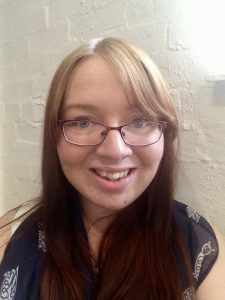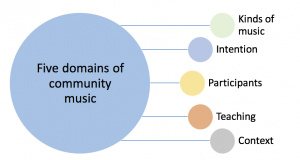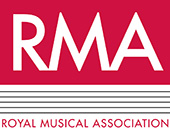 This month, Debbie Rodgers, a PhD candidate at Canterbury Christ Church University, offers a fascinating post on her research into the application of community music as a means of tackling mental health related stigma.
This month, Debbie Rodgers, a PhD candidate at Canterbury Christ Church University, offers a fascinating post on her research into the application of community music as a means of tackling mental health related stigma.
“What is it that you do again?”
When typically asked what area my PhD research fell into, I frequently struggled to offer a clear answer.
I am currently investigating the potential for musical performance spaces to impact upon people’s attitudes towards mental health stigma, focusing upon the work of the Me2/Orchestra, which is based in Boston (US).
This multifaceted topic encapsulates elements of health sociology, music ecology, geography, identity, politics, perception, acoustics… a seemingly endless list of interdisciplinary topics which struggle to fall neatly into any predefined category.
One area that I didn’t necessarily believe that my research fell beneath was the banner of ‘community music’. My very limited understanding of the discipline was focused upon a fuzzy notion of workshops, improvisation and precious little else.
However, it was last year when I attended the annual Student Seminar of the International Centre for Community Music that I began to change my mind.
In search of definition
One of the seemingly perpetual themes that frequently re-emerges in community music scholarship is that of definition (or lack of).
What is it? Who is it for? What purpose or value does it have? What makes a ‘community musician’? How do we research community music? Do we even need a definition?
Broad questions indeed, which invariably attract an equally broad scope of suggestions and answers dependent upon the focus of ethos, history or individual artistic practice. Perhaps a stumbling block to be expected when trying to define a term which incorporates the words ‘music’ and ‘community’ within it. Even in 1955, Hillery identified ninety-four possible definitions of community before perhaps inevitably concluding that there is ‘no complete agreement as to the nature of community’ (Hillery, 1955, p. 119).
Contemporary discussion has since moved away from focusing specifically upon what community music is to a more general discussion of what it actually does.
In answer to this, Kari Veblen neatly summarises the different ‘domains of community music’ as:

Community music is inclusive of all genres and styles of music, with a focus upon active music-making activities such as performance, composition and improvisation.
An emphasis is placed upon lifelong learning and open access to participation for all, and a belief that the social and personal well-being of participants should be on an equal footing with the musical learning and output of the group.
It serves to bring people from all social backgrounds and statuses together and fosters the opportunity for the development of both personal and group identity. (Veblen, 2004; Higgins, 2007).
Discovering more about the varied, inclusive nature of community music and the emphasis placed upon social change and personal development struck a chord with the focus of my interdisciplinary research and led me to become further involved with a growing community of researchers.
Fostering a research community of community musicians
Last November, I was privileged to attend the Student Seminar of the International Centre for Community Music (ICCM) which is based at York St John University.
An extensive effort has been made by the ICCM to reach out to community music scholars and practitioners around the world through collaboration with the SAGE Gateshead, Sound Sense and Wilfred Laurier University.
Student researchers at both undergraduate and postgraduate levels are encouraged to participate in symposiums and conferences from an early stage to showcase their work-in-progress, gain feedback, build connections and join in discussions with established academics in a supportive atmosphere. A student-led journal is also in the process of being launched with an aim of encouraging researchers to learn more about publication from both sides of the process.
This inclusive platform has also seen the development of new research methodologies and approaches designed to fit the requirements of individual participants.
A Skype collaboration with Wilfred Laurier University, Canada during the symposium allowed for an international group discussion about an innovative methodology designed to evaluate the impact of a community music group upon families. Children present at the weekly sessions were asked to draw pictures of themselves and their families throughout the process. This proved to be an illuminating methodology which enabled very young children to engage fully with the research taking place and provide an on-going representation of their self-confidence, mood and relationship with their family.
Ryan Humphreys, an undergraduate student based at the SAGE Gateshead gave an inspiring presentation about his research on a music project for foster families. The project developed an informal form of ethnographic assessment by providing each family with blank sheets of paper to write about what they felt that they had personally taken from the workshop, before subsequently developing an evaluation framework drawn from common themes highlighted in responses. This open-ended approach was driven by the participants and captured a depth of individual experience which placed value upon the optional element of the workshops which allowed families to opt in or out of participating as they wished, rather than being put under pressure to participate.
Becoming part of an inclusive community of researchers via the ICCM has enabled me to engage with a broad field of discussion and this in turn has given me increased confidence when approaching the methodology design for my own research. I have subsequently been able to collaborate with the Me2/Orchestra to design a highly personalised combination of methods which I feel will enable me to capture their ‘stigma-free zone’ performance space in action.
Bibliography
Higgins, L., 2007. Acts of hospitality: the community in Community Music. Music Education Research , 9(2), pp. 281-292.
Hillery, G., 1955. Definitions of community: areas of agreement. Rural Society, 20, pp. 111-123.
Veblen, K., 2004. The many ways of community music. International Journal of Community Music, 1, pp. 8-16.
Useful links
The International Centre for Community Music https://www.yorksj.ac.uk/iccm/
The Me2/Orchestra https://me2orchestra.org
